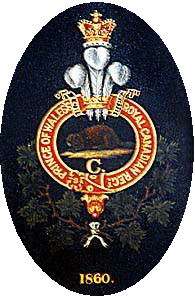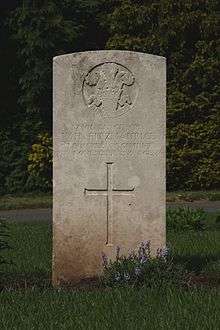Prince of Wales's Leinster Regiment (Royal Canadians)
| Prince of Wales's Leinster Regiment | |
|---|---|
 Badge of the Prince of Wales's Leinster Regiment | |
| Active | 1881–1922 |
| Allegiance |
|
| Branch |
|
| Type | Infantry Regiment |
| Role | Line Infantry |
| Size |
2 Regular Battalions |
| Garrison/HQ | Crinkill Barracks, Birr |
| Nickname(s) | Royal Canadians |
| Patron | Prince of Wales |
| Motto(s) | Ich Dien (I Serve) |
| March | Quick: Come Back to Erin |
The Prince of Wales's Leinster Regiment (Royal Canadians) was an infantry regiment of the line in the British Army, formed in 1881 by the amalgamation of the 100th (Prince of Wales's Royal Canadian) Regiment of Foot and the 109th Regiment of Foot (Bombay Infantry). The 100th Foot was first raised in 1763 and the 109th was first raised in 1761.[1][2][3] Between the time of its formation and Irish independence, it was one of eight Irish regiments raised largely in Ireland, its home depot in Birr.[4] It was disbanded with the Partition of Ireland following establishment of the independent Irish Free State in 1922 when the five regiments that had their traditional recruiting grounds in the counties of the new state were disbanded.[5]
Nineteenth Century

The regiment was formed in 1881 by the amalgamation of the 100th (Prince of Wales's Royal Canadian) Regiment of Foot and the 109th Regiment of Foot (Bombay Infantry). The amalgamation of the two regiments into one with the title Prince of Wales's Leinster Regiment (Royal Canadians), was part of the United Kingdom government's reorganization of the British Army under the Childers Reforms, a continuation of the Cardwell Reforms implemented in 1879.[6]
It was one of eight Irish regiments raised largely in Ireland, with its home depot at Crinkill Barracks in Birr.[7] The regiment recruited mainly in the province of Leinster. Militarily, the whole of Ireland was administered as a separate command within the United Kingdom with Command Headquarters at Parkgate (Phoenix Park) in Dublin, directly under the War Office in London.[8]
The 1st Battalion, which had been in India to Ireland in 1894. A detachment took part in the Fourth Anglo-Ashanti War in 1895, but the rest of the battalion remained in Ireland until moving to Halifax, Canada, in 1898.[9] The 2nd Battalion moved to Ireland in 1882 and to England in 1888. It transferred to Malta in 1894, and joined the Bermuda Garrison the following year. In 1897, it moved to Halifax, and in 1898 to the West Indies.[9]
Second Boer War
Both regular battalions were deployed to South Africa for the Second Boer War. The 1st Battalion saw action around Bethlehem on April 1902 when 14 men were wounded while the 2nd Battalion held the Heilbron branch line in February 1902 when they had 10 casualties.[10] A 3rd Militia Battalion, formed from the former King′s County Militia, was embodied in early 1900 for service in South Africa. They embarked in early March 1900, returning to Ireland after more than two years in late May 1902.[11]
First World War

Regular Army
The 1st Battalion, which had been at Faizabad in India, landed at Le Havre as part of the 82nd Brigade in the 27th Division in December 1914 for service on the Western Front but moved to Salonika in December 1915 and then moved to Egypt for service in Palestine in September 1917.[12] The 2nd Battalion landed at Saint-Nazaire as part of the 17th Brigade in the 6th Division in September 1914 for service on the Western Front.[12]
New Armies
The 6th (Service) Battalion landed at Anzac Cove as part of the 29th Brigade in the 10th (Irish) Division in August 1915 but moved to Salonika in September 1915 and on to Egypt for service in Palestine in September 1917 before landing at Marseille in June 1918 for service on the Western Front.[12] The 7th Battalion landed at Le Havre as part of the 47th Brigade in the 16th (Irish) Division in December 1915 for service on the Western Front.[12]
Disbandment

Due to substantial defence cuts and the establishment of the Irish Free State in 1922, it was agreed that the six former Southern Ireland regiments would be disbanded,[13][5] including the Prince of Wales's Leinster Regiment (Royal Canadians). On 12 June, five regimental colours were laid up in a ceremony at St George's Hall, Windsor Castle in the presence of HM King George V.[14] The six regiments were then all disbanded on 31 July 1922.[15] With the simultaneous outbreak of the Irish Civil War conflict some thousands of their ex-servicemen and officers contributed to expanding the Free State government's newly formed National Army. They brought considerable combat experience with them and by May 1923 comprised 50 per cent of its 53,000 soldiers and 20 per cent of its officers.[16]
In recognition of their Canadian roots, the officers of the 1st Battalion decided to give their officers' mess silver 'in trust' to the Government of Canada "as a token of the regard for the Great Dominion which gave birth to the Battalion to be held in trust until such time as the Battalion is again raised". The silver, known as "The Leinster Plate", was deposited for safe keeping at the Royal Military College of Canada in 1923 at the suggestion of then Minister of National Defence, the Hon. Edward Mortimer Macdonald, and of Major-General James MacBrien, the Canadian Chief of Staff. The silver is on display at Royal Military College of Canada in the Senior Staff Mess and Museum (Fort Frederic).[17]
In 2013 the Regimental Association erected a memorial to commemorate the regiment's strong linkages with the Birr area, particularly to Crinkill Barracks.[18]
Battle honours

The regiment's battle honours were as follows:[15]
- From 100th Regiment of Foot: Niagara
- From 109th Regiment of Foot: Central India
- Second Boer War: South Africa 1900–02
- The Great War:
| Campaign | Battle | Date |
|---|---|---|
| None | Armentières 1914 | 1914 |
| Second Battle of Ypres | Battle of Gravenstafel | 22–23 April 1915 |
| Battle of St. Julien | 24 April – 4 May 1915 | |
| Battle of Frezenberg | 8–13 May 1915 | |
| Battle of the Somme | Bourlon Wood | |
| Battle of Guillemont | 3–6 September 1916 | |
| Battle of Ginchy | 9 September 1916 | |
| Battle of Arras | Battle of Vimy Ridge | 9 – 14 April 1917 |
| Third Battle of Ypres | Battle of Messines | 7 – 14 June 1917 |
| Battle of Pilckem Ridge | 31 July – 3 August 1917 | |
| Battle of Langemarck (1917) | 16–18 August 1917 | |
| First Battle of Passchendaele | 12 October 1917 | |
| Second Battle of Passchendaele | 26 October – 10 November 1917 | |
| The German Offensives 1918 | First Battles of the Somme, 1918 | |
| St. Quentin | 21–23 March 1918 | |
| Actions at the Somme Crossings | 24–25 March 1918 | |
| Battle of Rosieres | 26–27 March 1918 | |
| Courtrai 1918 | 28 June 1918 | |
| The Advance To Victory 1918 | Battle of Amiens | 8 – 11 August 1918 |
| Second Battles of the Somme, 1918 | Delville Wood | |
| Cambrai, 1918 (Capture of Cambrai) | 8–9 October 1918 | |
| Battle of Ypres, 1918 | 28 September – 2 October 1918 | |
| Battle of Courtrai | 14–19 October 1918 | |
| Macedonia 1915–17 | Battle of Kastrino | |
| Battle of Struma | ||
| Gallipoli 1915 | Suvla | |
| Sari Bair | ||
| Palestine 1917–18 | First Battle of Gaza | 26 March 1917 |
| Battle of Jerusalem (1917) | 26–30 December 1917 | |
| Battle of Megiddo (1918) | 19 and 25 September 1918 | |
| Nablus | 19 and 25 September 1918 | |
| Battle of Tell 'Asur | 8 and 12 March 1918 |
Victoria Cross recipients
- Lieutenant John Vincent Holland, Great War
- Corporal John Cunningham, Great War
- Private Martin Joseph Moffat, Great War
Notes
- ↑ Harris 1999, pp. 192-203 In March 1858 authority was granted to raise in Canada, a regiment for imperial service to be known as the 100th Royal Canadian Regiment. The “New 100th” considered itself a reactivation of the “Old 100th”.
- ↑ Harris 1999, p. 193.
- ↑ The 100th Regiment served in the War of 1812–14 against the United States. The Regiment was in Quebec from 1866 to 1868 as part of the Montreal garrison. The regiment paraded with its headdress decorated with maple leaves on the first “Dominion Day”, 1 July 1867. The Regiment participated in the Indian Mutiny.
- ↑ Harris 1968, pp. 216–217 Table listing the eight Irish Regiments of the British Army July 1914, their Depots, Reserve Bns., and local Militia.: Royal Irish Regiment Depot Clonmel, Royal Inniskilling Fusiliers Depot Omagh, Royal Irish Rifles Depot Belfast, Royal Irish Fusiliers (Princess Victoria's) Depot Armagh, Connaught Rangers Depot Galway, Leinster Regiment Depot Birr, Royal Munster Fusiliers Depot Tralee, Royal Dublin Fusiliers Depot Naas.
- 1 2 Murphy 2007, pp. 30 quote: "Following the treaty that established the independent Irish Free State in 1922, it was decided to disband the regiments that had their traditional recruiting grounds in southern Ireland: The Royal Irish Regiment; The Connaught Rangers; The Prince of Wales' Leinster Regiment; The Royal Munster Fusiliers; The Royal Dublin Fusiliers; The South Irish Horse"
- ↑ The London Gazette: no. 24992. pp. 3300–3301. 1 July 1881.
- ↑ "Crinkle". Birr History Society. Retrieved 18 November 2014.
- ↑ Harris 1968, pp. 2–3.
- 1 2 "Prince of Wales's Leinster Regiment (Royal Canadians)". National Army Museum. Retrieved 16 July 2016.
- ↑ "Prince of Wales's Leinster Regiment (Royal Canadians)". Anglo-Boer War. Retrieved 16 July 2016.
- ↑ "The War - Return of troops". The Times (36780). London. 29 May 1902. p. 7.
- 1 2 3 4 "Prince of Wales's Leinster Regiment (Royal Canadians)". The Long Long Trail. Retrieved 16 July 2016.
- ↑ Army Order 78/1922
- ↑ Harris 1968, pp. 209
- 1 2 "The Prince of Wales's Leinster Regiment (Royal Canadians)". Regiments.org. Retrieved 16 May 2016.
- ↑ Cottrell 2008, pp. 23
- ↑ "Leinster Silver Plate Collection at the Royal Military College of Canada Museum in Kingston, Ontario". Archived from the original on 17 August 2011.
- ↑ "Leinster Regiment Memorial Birr". Leinster Regiment Association. Retrieved 18 November 2014.
References
- Cottrell, Peter (2008). The Irish Civil War 1922-23, Saorstát Éireann Forces. Osprey Publishing Ltd. ISBN 978-1-84603-270-7.
- Harris, Henry E.D. (1968). The Irish Regiments in the First World War. Cork: Mercier Press. ISBN 978-0853420729.
- Harris, R.G. (1999) [1989]. "Prince of Wales's Leinster Regiment (Royal Canadians)". The Irish Regiments 1689-1999. New York: Sarpedon. ISBN 1-885119-62-3.
- Hitchcock, F.C. (2009). Stand To, a Diary of the Trenches 1915–1918. Naval & Military Press. ISBN 978-1843421603.
- Murphy, David (2007). Irish Regiments in the World Wars. Osprey Publishing. ISBN 978-1-84603-015-4.
- Whitton, F.C. (2004). Prince of Wales's Leinster Regiment (Royal Canadians): the History of the Prince of Wales’s Leinster Regiment (Royal Canadians), late the 100th Prince of Wales Royal Canadian Regiment. 2 volumes. Naval & Military Press. ISBN 978-1843427988.
External links
| Wikimedia Commons has media related to Prince of Wales's Leinster Regiment. |
- Mills, T.F. "The Prince of Wales's Leinster Regiment (Royal Canadians)". regiments.org. Archived from the original on February 12, 2007. Retrieved 15 April 2007. Includes chronological index of titles.
- "Irish Soldiers in the First World War". Department of the Taoiseach. 2011.
- "Queen Victoria's Royal Canadians".
